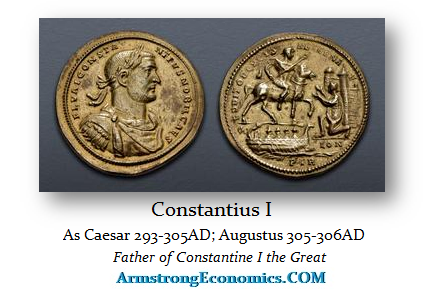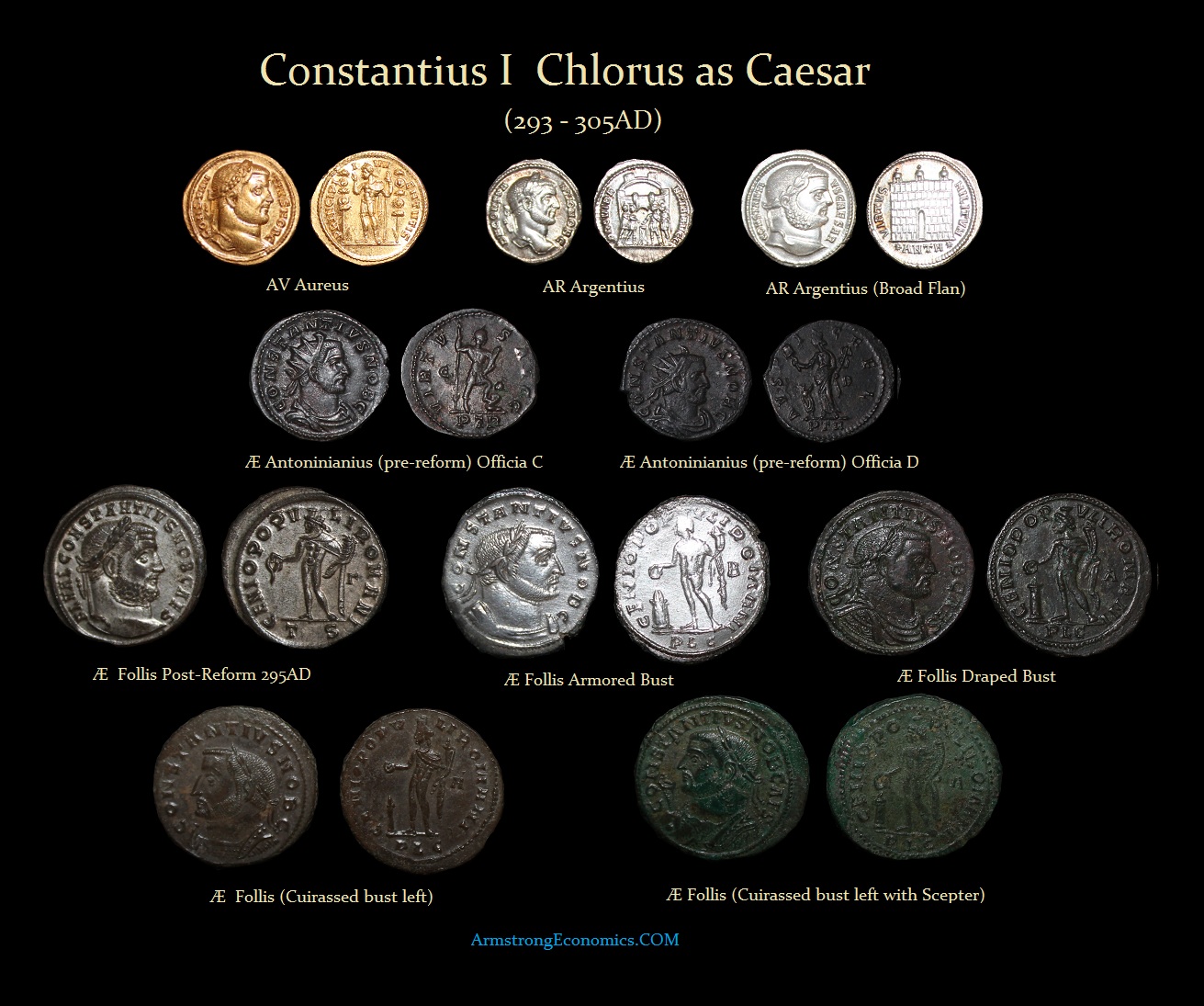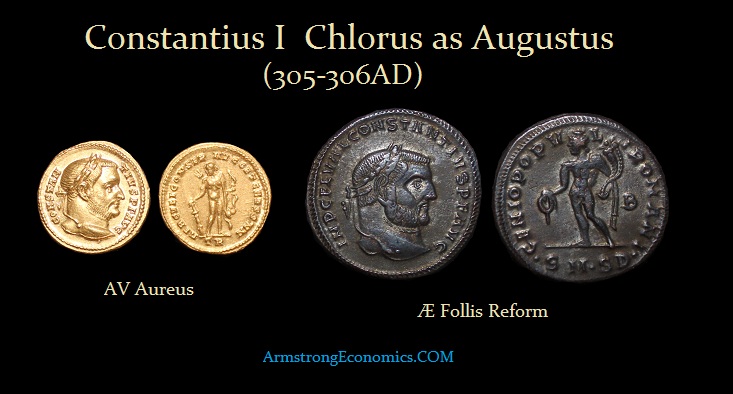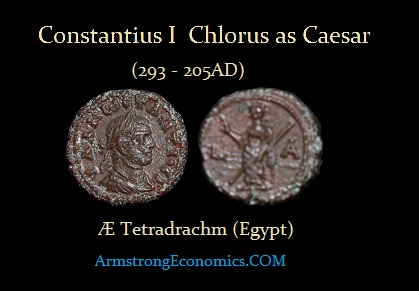Constantius I Chlorus
305 – 306 AD
As Caesar, 293 – 305 AD
Flavius Valerius Constantius I Chlorus was most likely born in the Danube region. Constantius fell in love with an innkeeper’s daughter named Helena in Naissus, located in Upper Dacia. This is the location of the birth of their first son, who would later become known to history as Constantine I the Great. Despite later claims of being a descendant of the former Emperor Claudius II Gothicus by his son Constantine, there was no connection. The story was merely fictitious to legitimize Constantine’s ambition for power.
Little is known of the early career of Constantius Chlorus. He had risen in stature to become Governor of Dalmatia. Following the death of Numerian, Diocletian, who had been commander of the Praetorian Guard, was proclaimed Emperor by the troops in 284 AD and, following the assassination of Carinus, emerged as sole ruler of the Roman Empire by 285 AD. Constantius Chlorus must have proven himself a loyal and trustworthy military leader. Sometime before 293 AD, Constantius had risen to Prefect of the Praetorian Guard under Diocletian. Another military leader came to power named Maximianus when a revolt broke out in Gaul, and Diocletian sent him against Amandus and Aelianus. Upon his successful conquest over the Gaulish usurpers, Maximianus was given the rank of co-Augustus by Diocletian in 286 AD.
Diocletian’s abilities were much more so in the field of reform and statesmanship, while Maximianus was the popular leader in the Army. Thus, Diocletian’s vision of a stable rule was establishing a system known as the Tetrarchy whereby two joint Augustii would rule with two junior Caesars as heirs in the wings who served as Consuls. During that time, Constantius followed his ambition by divorcing Helena in favor of a marriage link with the new co-ruler, Maximianus, with his daughter, Theodora.
In 293 AD, Constantius was admitted to Diocletian’s new vision by being raised to the rank of Caesar. It was, therefore, his role to serve under Maximianus in the West while Diocletian concentrated on ruling the Eastern provinces. At the same time, Galerius, another leader who had risen through the ranks of the military, was also given the rank of Caesar. Galerius also divorced his wife and married Valeria, the daughter of Diocletian. It was at this time that the Tetrarchy was created.
Discovered in the Arras Hoard
Constantius’ first task was to regain the territories under the usurper Carausius – Britain and part of Gaul. Maximianus had tried to defeat Carausius with little success. Therefore, the task now fell to Constantius. His first move was to blockade Carausius’ stronghold in northern Gaul – Gesoriacum (modern Boulogne) in 293 AD. Carausius later died at the hands of his own ambitious minister, Allectus, before Constantius was prepared to invade Britain. Finally, in 296 AD, Constantius began his invasion but personally was unable to land. A second fleet, commanded by Asclepiodotus (Praetorian Prefect to Constantius), succeeded in not only land but also engaged and defeated Allectus. The glory, however, still went to Constantius, as this gold medallion illustrates. Here, we see Constantius being portrayed as the savior of London.
During Constantius’ rule, he did much to strengthen the frontier along the Rhine. He also began an extensive building project at Trier, the capital city of Treviri, in the Gallia Belgica region. Trier was located on the Moselle River just east of modern-day Luxembourg. Trier rose as a significant center under Constantius, who chose this city as the operations center for his new Caesar. Constantius began constructing a large imperial palace that occupied much of the city’s eastern portion. Much of these projects were later completed by his son, including the famous Gates of Trier – Porta Nigra.
In 305 AD, Diocletian became the first Emperor ever to abdicate, and Maximianus was forced to do the same. Their successors thus became Constantius I Chlorus and Galerius. But the Tetrarchy was already showing signs of strain. Galerius was a ruthless ruler who took great pleasure in persecuting Christians. He held the more powerful East, and to further strengthen his hand, he held Constantius’ son, Constantine the Great, hostage at his court.
At this time, there was a tremendous barbarian invasion of Britain on the part of the Picts, which provided the excuse for Constantius’ request that his son be allowed to join him in defending the Empire. On July 25th, 306 AD, Constantius Chlorus died in Britain at York, leaving his son Constantine to face Galerius alone. Constantius had won the loyalty and admiration of his troops, which would prove invaluable to his son in his quest for power.
Monetary System
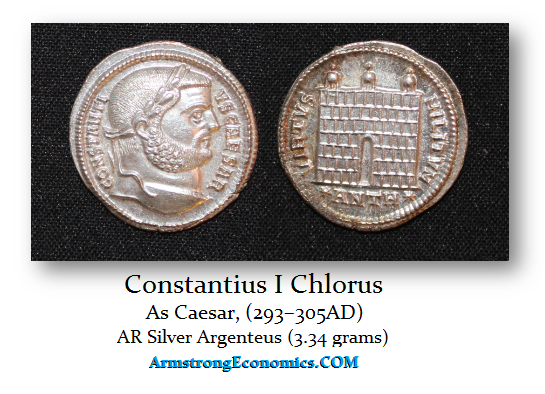
Mints: Alexandria, Antioch, Aquileia, Carthage, Cyzicus, Heraclea, London, Lugdunum, Nicomedia, Rome, Siscia, Serdica, Ticinum, Treveri
Obverse Legends:
As Caesar
CONSTANTIVS NOB CAES
CONSTANTIVS CAES
CONSTANTIVS NOB C
FL VAL CONSTANTIVS NOB CAES
FL VAL CONSTANTIVS NOB C
As Augustus
CONSTANTIVS P F AVG
CONSTANTIVS AVG
IMP C CONSTANTIVS P F AVG
IMP CONSTANTIVS P F AVG
Monetary Reform
NOTE: The monetary system as employed by Constantius I was that of Diocletian’s Reform.The early issues of the silver argentius display a large wide flan with a weight of about 3.2 grams. This coin quickly became reduced in diameter and weight dropping under 3 grams fairly quickly. The portrait styles became fairly idealized for all members of the Tetrarchy in an attempt to display a unity among the two Augustii and two Caesars.
DENOMINATIONS
As Caesar (293 – 305 AD)
AU DOUBLE Aureus (12.00 grams)
AU Aureus (6.03 grams)
AR Argentius (3.34 grams)
AR Reduced Argentius (small flan 2.9 grams)
Æ Antoninianus
Æ Denarius
Æ Quinarius
Æ Tetradrachm (Egypt 7.07 grams)
Post-Reform Bronze
Æ Follis
As Augustus (305 – 306 AD)
AU Aureus (6.54 grams)
AR Argenteus
Æ Antoninianus
Æ Follis
Æ 1/4 Follis
EGYPT
Æ Tetradrachm (Egypt)
POSTHUMOUS COINAGE
Note: Posthumous coinage in honor of Constantius was issued by Constantine and by his ally Maxentius. Maximianus, Constantius and Galerius were the last emperors to receive divine honors, for after Constantine’s recognition of Christianity the whole concept of deification became impossible. The only exception to this is the enigmatic Divus Constantinus Pater Augusto rum coinage of Constantine himself.
Struck by Maxentius
Æ Follis – (Veiled portrait right)
Struck by Constantine
Æ Follis – (Laurel head right)
Æ Follis – (Laurel and Veiled head right)
ƽ Follis – (Laurel and Veiled head right)
Æ3 Reduced Follis – (Laurel and Veiled head right)
Æ4 Reduced Follis – (Laurel and Veiled head right)


